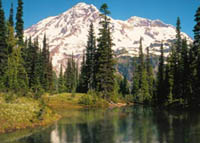Among the Northwest’s best natural strongholds are its vast wild spaces, which retain the ecological integrity vital to the region’s prosperity and quality of life.
A key way to protect the region’s intact landscapes is to expand roadless areas. Roads are not only indicators of the physical scale of northwesterners’ real-estate development and logging but they are also a first-order ecological problem in themselves.
Roads fragment previously intact ecosystems, speed the spread of invasive organisms, cause landslides on steep slopes, and send pollution and sediment into nearby waterways.
Roadless forests and watersheds offer sanctuary for salmon and Sitka spruce; for keystone predators like grizzly bears, whose presence structures entire food webs; and for an invisible foundation of fungi and microorganisms.
They sustain the ancient regenerating rhythms of fire and flood and provide humans with benefits ranging from clean water and moderate climates to crop pollination and recreation.
The good news: Forest roads on the decline
We’ve made progress. In This Place on Earth 2002, we reported that after three decades of steady growth, we reduced the pace of road construction tenfold in national forests and obliterated more national forest roads than we built.
The building boom in national forests peaked around 1980, when the US Forest Service constructed (and reconstructed) about 5,000 miles of logging roads across the Pacific Northwest in a single year.
In the early 1990s, the Forest Service officially shifted its emphasis from logging to ecosystem management, and road building fell to about one-tenth its former level.
Expanding our share of wildness
Through public and private initiatives, the Northwest can expand its share of wildness. This share is already growing, though parks and monuments still concentrate in scenic and relatively barren alpine zones. Between 1991 and 2000, British Columbia doubled its protected lands, safeguarding 14 million acres (5.7 million hectares)-an area one-third the size of Washington.
Another significant step was former President Clinton’s famous “roadless rule.” Better monitoring of the Northwest’s road network is also critical. The inventoried streets, highways, and Forest Service roads we charted may account for only half of all roads that spread across the region. Unrecorded “ghost roads” are commonplace on national forest lands.
BC’s enormous public lands are laced with logging roads built by timber companies, which are not required to release to the public information on their full-throttle road construction. And lands managed by private timber owners, state agencies, the US Bureau of Land Management, and others hold tens of thousands of miles of additional roads.
Including streets, highways, and forest roads, the Northwest’s road network likely stretches more than 800,000 miles, enough to circle the equator 32 times and roughly as far as all the region’s streams taken together. This means that cars and trucks may now have better access to the outdoors than do salmon.
Humans have radically altered Northwest ecosystems, but the region still possesses many of its wild genes, native communities, and natural processes. Blessed with this wealth, northwesterners retain the means to weave into nature’s fabric a durable human economy.








